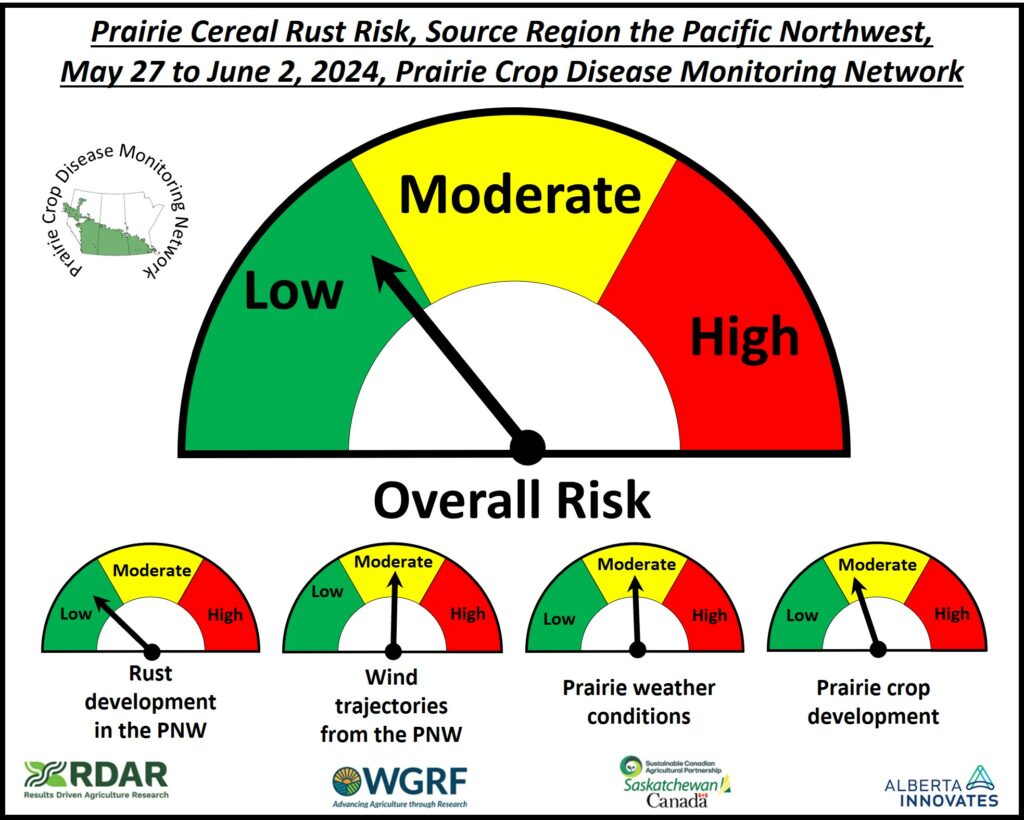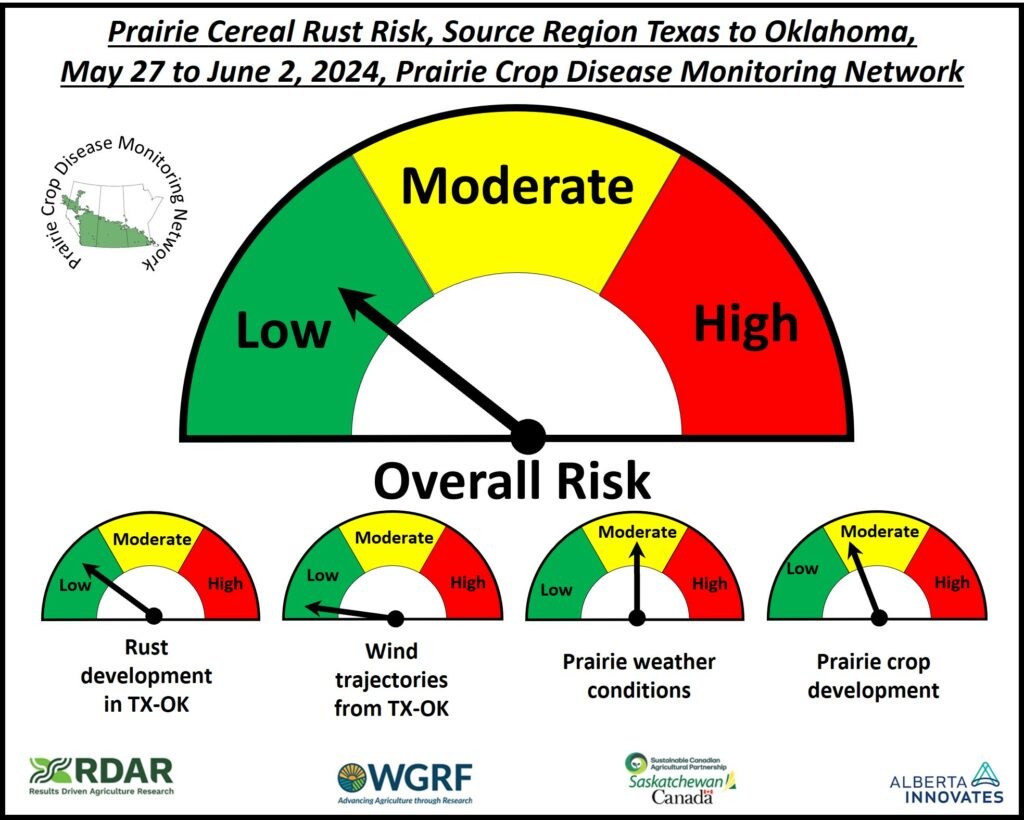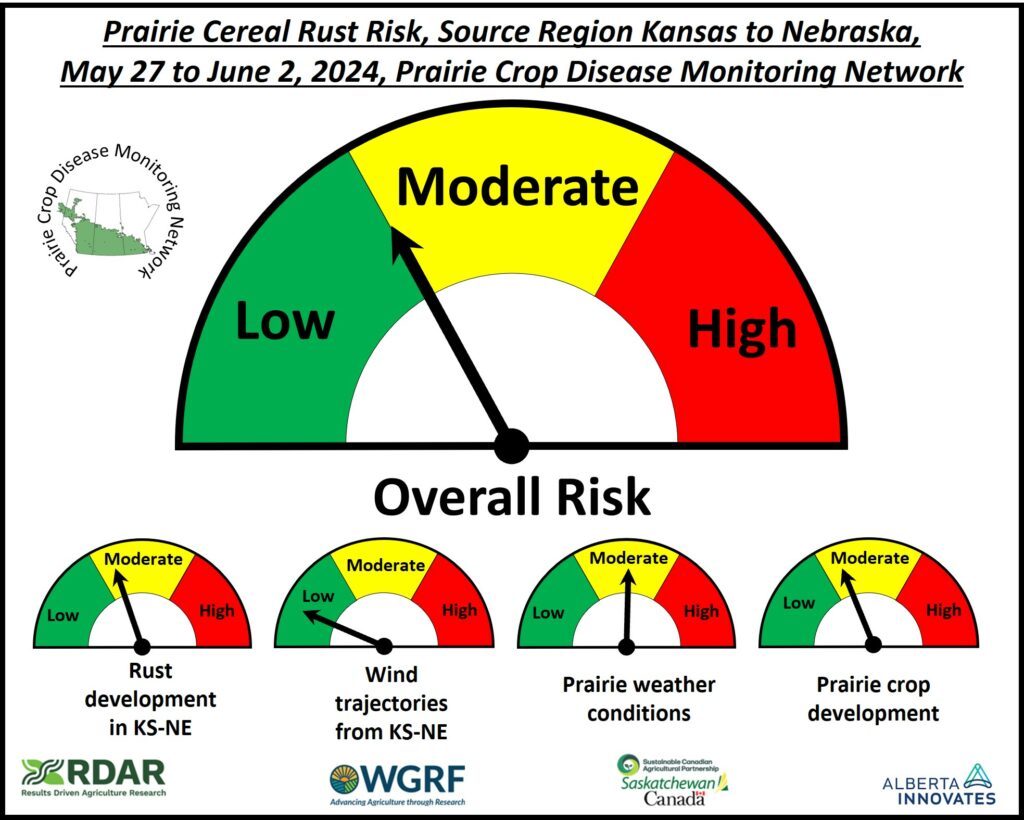The fourth weekly Prairie wind trajectory cereal rust risk report for 2024 is available for download now at the following link: May 27-June 2, 2024 report.
As of the week of May 27-June 2, 2024, the overall Prairie cereal rust risk assessment and need for in-crop scouting is as follows:
Pacific Northwest – There were moderate numbers of reverse wind trajectories that passed over the PNW region and into the Prairies, while stripe rust development is limited in commercial fields although there are concerns that it could restart in previously sprayed commercial crops. Prairie winter wheat crops are progressing past the stem elongation stages and into flag leaf emergence and booting, while much of the spring wheat crop has now been seeded. Overall, as of June 4, 2024, the risk of stripe rust appearance from the PNW is relatively low and scouting for this disease in the Prairie region is generally not urgent.

Texas-Oklahoma corridor – There were only two reverse wind trajectories that passed over the TX/OK region and into the Prairies from May 27 to June 2, 2024, while stripe and leaf rust have been reported, although levels appear to be generally low, especially in commercial winter wheat fields in this region. As Texas and Kansas winter wheat crops move towards maturity and harvest, they will no longer represent a source of rust inoculum for the Prairie region. Prairie winter wheat crops are progressing past the stem elongation stages and into flag leaf emergence and booting, while much of the spring wheat crop has now been seeded. Overall, as of June 4, 2024, the risk of stem, leaf, stripe, and crown rust appearance from the Texas-Oklahoma corridor is relatively low and scouting for these diseases in the Prairie region is not urgent.

Kansas-Nebraska corridor – There only 13 reverse wind trajectories that passed over the KS/NE region and into the Prairies from May 27 to June 2, 2024, while stripe and leaf rust (Kansas) development are continuing in commercial winter wheat fields in this region, with numerous reports of low levels in Nebraska, although elevated levels have been reported in unsprayed fields, especially where the variety planted was susceptible. Prairie winter wheat crops are progressing past the stem elongation stages and into flag leaf emergence and booting, while much of the spring wheat crop has now been seeded. Rainfall amounts in most of Manitoba and eastern Saskatchewan could facilitate deposition of rust spores into cereal crops and subsequent disease development. Overall, as of June 4, 2024, the risk of stem, leaf, stripe, and crown rust appearance from the Kansas-Nebraska corridor is low-moderate and scouting for these diseases in the Prairies is generally not urgent.

The early and widespread appearance of stripe rust in the PNW, TX/OK and KS/NE regions is still concerning, while the recent stripe rust observations from South Dakota and Wisconsin bring the stripe rust issue ever closer to the Prairies, especially the central to eastern region. Over the next 2-4 weeks if favourable weather conditions (especially more rainfall) occur in these source US regions, further rust development could occur. This would result in more rust spores being available to be blown into the Prairie region, as well as more northerly rust development into the Dakotas and Minnesota/Wisconsin. Currently, Prairie winter wheat fields are most at risk, but fortunately most current winter wheat varieties have intermediate to high levels of resistance, although AC Radiant, CDC Buteo, AAC Elevate, Broadview, and CDC Falcon are rated as susceptible (https://www.seed.ab.ca/variety-data/cereals/; https://saskseed.ca/wp-content/uploads/2020/12/2024-Varieties-of-Grain-Crops.pdf; https://www.seedmb.ca/pdf-editions-and-separate-section-pdfs/). In terms of spring wheat (various classes) and durum the following varieties are either an S or MS: 5700PR, AAC Cameron, AAC Iceberg, AAC Tisdale, AAC Tomkins, AAC Warman, AAC Whitefox, AC Foremost , Cardale, CDC Abound, CDC Adamant, CDC Flare, CDC Pilar, Faller, Prosper, SY Natron, SY Rorke, SY Torach, and Unity. If you are growing a stripe rust susceptible variety, it will be important to keep an eye on your crops and follow further PCDMN cereal risk updates.

